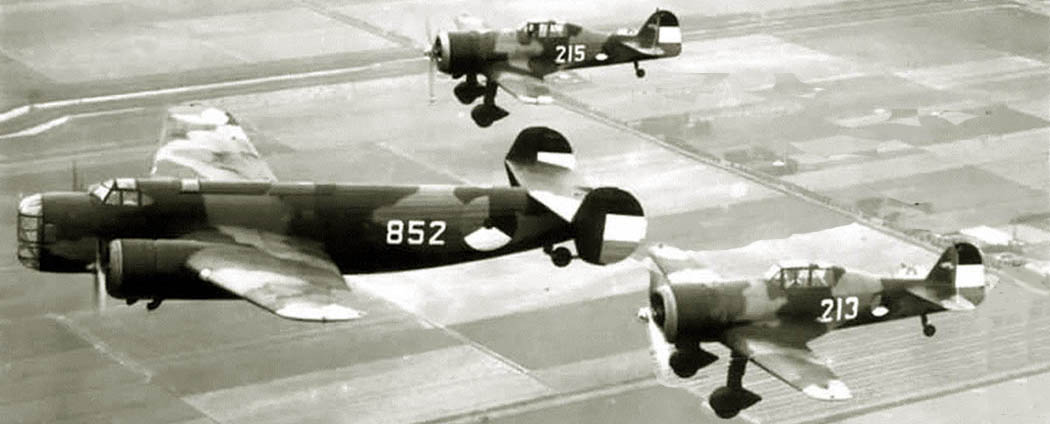
Aviation of World War II


 |
Aviation of World War II |


|
|
Soviet Union | Lend - Lease | Facts | Forum | Germany | Japan | R A F | U S A A F | Other | Photos | ||||||||||||||||||||||||||||||||||||||||
Fokker T.VMedium BomberFokker
Holland, where in the early 1930s its own vision of the concept of an "air cruiser" - Luchtkruiser, focused primarily on defense, was formed, since Holland had not planned any offensive wars with its neighbors since the beginning of the 19th century. In accordance with this concept, the new aircraft, designed to become the basis of the Dutch military aviation, was supposed to ensure air superiority over its own territory. A long flight duration was required to carry out long patrols and intercept enemy bombers at distant approaches. In addition, the significant combat radius made it possible to use the aircraft for the defense of vast possessions in the Dutch East Indies. Small arms were provided for very powerful at that time - two 20-mm cannons and several machine guns. At the beginning of 1933, a proposal to design an "air cruiser" was sent to the leading Dutch aircraft manufacturer - Fokker. The design group was headed by engineer F. Hentzen, and M. Beeling supervised the development. However, the first version of the preliminary design did not meet with the customer's approval. Therefore, in March 1934, Hentzen was replaced by the famous designer Erich Schatzky. Although the aircraft was still listed as an "air cruiser," it was actually considered a medium bomber. On February 14, 1938, the official ceremony of handing over the first Fokker T.V to the military took place at Susterberg airbase. During the year LVA (Luhtvaartafdeeling - Netherlands Air Force) received ten more such machines (numbers 851-860). The arrival of new aircraft made it possible to form the BomVa (Bombardement Vliegafdeeling) bomber air group. In 1939, the company produced the last five Fokker T.Vs, but this batch, although operated in BomVa, was not officially accepted by the customer - the contract with Fokker was terminated under the pretext of low technical reliability of its bombers. In addition, the operation showed a much higher than anticipated oil consumption for the Pegasus engines. The company was forced to carry out improvements on the already delivered machines, installing oil tanks of increased capacity. A total of 16 production aircraft were produced, the prototype was not manufactured.
Construction . Fuselage of a cross-section close to oval with flat sides, mixed design. Technologically, it is divided into three sections. The bow section with the cockpit of the bombardier navigator is a duralumin monocoque. The middle one, made as a whole with the wing, is made of wood with plywood sheathing. The tail section is a welded steel pipe truss sheathed with percale. Two-spar wing, all-wood construction with plywood sheathing. The center section is rectangular in plan, the outer parts of the wing are trepeziform with rounded tips. Center section profile NACA 23017, external parts - NACA 23009. Wing angle 8.5 °. Aileron metal with linen sheathing. The tail unit is of mixed construction with linen plating. The horizontal tail is supported by struts. Powertrain - two 9-cylinder Bristol Pegasus XXVI radial motors optimized for mid-range heights. Takeoff power of each - 830 hp; 925 h.p. - at an altitude of 2900 m. Three-bladed Hamilton Standard propellers with a diameter of 3.05 m. Fuel system - two tanks in the center section, with a capacity of 750 liters each. Armament: 20-mm Solothurn cannon in the bow mount (ammunition from 10-round magazines; ammunition - 120 rounds) and four 7.92-mm FN Browning machine guns with 600 rounds of ammunition per barrel (one at the top, bottom, stern and airborne installations); up to 1000 kg of bombs with caliber 50, 100, 200 and 300 kg in various combinations in the bomb bay (the bomb bay doors are hydraulic). Crew - 5 people: navigator-bombardier (who also served the cannon), pilot, gunner serving the upper unit (also known as reserve pilot), gunner-radio operator, gunner of the tail unit. | ||||||||||||||||||||||||||||||||||||||||
|
|
Bibliography
|